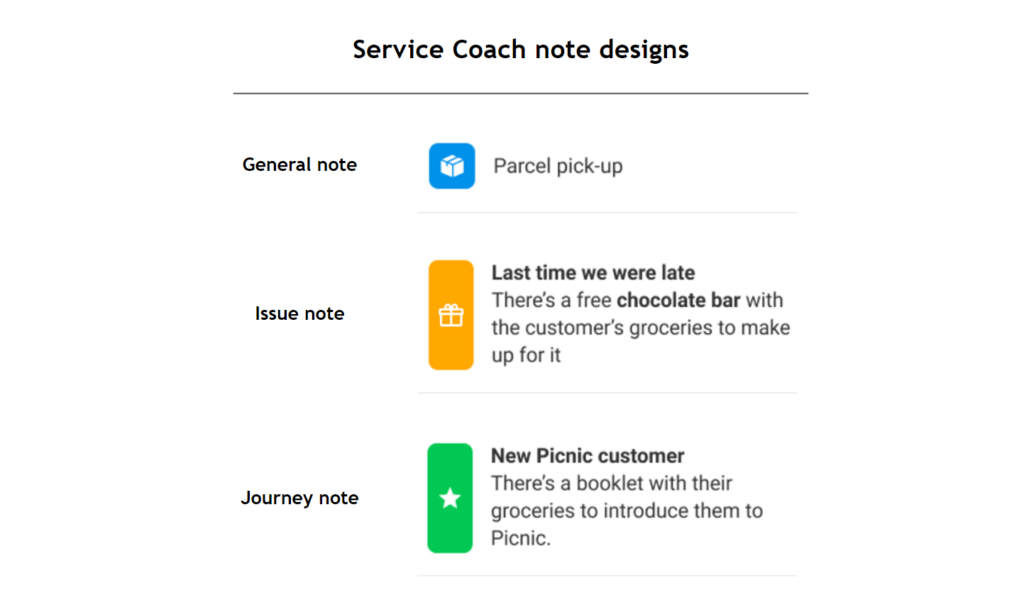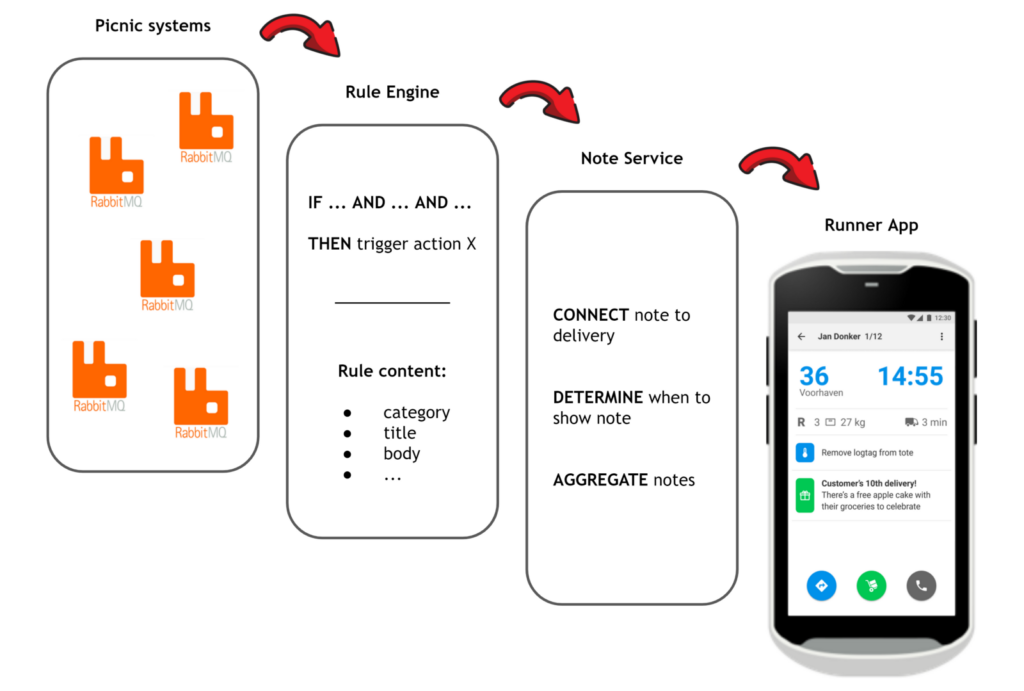Picture the local milkman doing his rounds in days gone by: climbing out of his truck and walking up to your door with a broad smile on his face, laden with bottles of fresh milk plus other goodies like eggs and cheese. His friendly nature and familiarity would shine through as he stopped for a short chat before collecting your empty bottles and strolling back to his truck, bidding you a good day.
At Picnic our mission is simple — we want to build the best milkman on earth. But as we’ve grown, reaching more and more customers across multiple countries, this has become a complex challenge. Our Runners (that’s what we call the heroes who deliver the groceries) can lack context about the customer and delivery — they might be unaware of a customer’s communications with us, or the details of a customer’s shopping journey in the Picnic app. As a result, there’s a risk that the customer experience during the delivery moment becomes disconnected and impersonal. The opposite of what made the local milkman so special.
So we started to ask ourselves: How can we better leverage our data to enhance our customers’ experience during the delivery moment?
Creating a personalized delivery experience
For most of our customers, the delivery moment is the only in-person interaction they have with us. Runners, as the face of Picnic at the door, therefore have a significant impact on customer satisfaction, and we realized there was an opportunity to help our Runners really ‘wow’ our customers by sharing more context about the delivery with them. By providing Runners with the right information at the right time, they have the insights needed to prevent and solve issues, and to create a magical delivery experience for the customer. Whether it’s informing customers about changes in their order, understanding their previous pain points, or highlighting gifts and celebrating milestones — these insights help add a personal touch, resulting in better service and happier customers.
All Picnic Runners use an Android OS mobile device that runs our home-built Runner app to support them in carrying out their work. Building in-house gives us flexibility, and we decided to create a new feature called the Service Coach which would share useful insights with Runners at the point of delivery, with the aim of helping to facilitate a fun, personal interaction with customers at their door.
Designing the Service Coach
To achieve our objective, we set out some basic design principles for the Service Coach notes, small pieces of information on a delivery, we would surface to Runners:
- A coach, not an autocue. We want to inspire and inform our Runners, but they will always be the star of the show. We don’t want to micromanage their customer interactions.
- Actionable insights. If Runners don’t know how to apply the insights we share with them, they won’t use these notes.
- Focused coaching. We don’t want to overwhelm Runners with information and will prioritise the most impactful points only.
To make sure we didn’t stray from this being ‘just a coach’ for Runners, we created a simple template and language style for the notes. This way all the notes are communicated in a manner that infers using them is completely voluntary, but that the insights can be fun and beneficial for Runners. To help ensure actionability, we developed different categories of notes to serve our use case and make it easier for Runners to identify them. We tested and validated these designs with Runners, and iterated until we struck the right tone and level of detail.

Determining which insights to share
Since the insights we want to share with Runners are dependent on the customer and delivery situation, plus are likely to change over time as our focus areas and priorities within Picnic shift, we made the decision to let anyone at Picnic create a note. Predominantly though, these actionable insights are generated by our various business analysts who have a deep understanding of what our data is telling us about our customer journey, and what we’re doing to make it even better. Therefore there are no constraints on which insights we create notes for, provided they fit the template and abide by the design principles. Each note, however, is created with a mini business case detailing the problem it aims to solve and its expected impact. This allows us to determine its priority and ensures we don’t overwhelm our Runners with delivery notes.
For example, we know that Runners incorrectly recording the deposits handed back to them is one of our customers’ biggest pain points, accounting for a large share of the negative Runner feedback we receive. And whilst the frequency of these deposit issues is low overall, the impact it has on an individual customer’s delivery experience is significant. So we created a note that provides Runners with a reminder to be extra attentive when handling the returns of a customer who had an issue with deposits in their previous delivery. This helps reduce this major pain point for customers and gives Runners the information needed to address the mistake we made during the last delivery.
It’s not just about taking up customer issues though, we also want to share insights with our Runners that help facilitate ‘wow’ interactions at the customer’s doorstep — for example, when a customer has their 10th Picnic order, we give them a delicious apple cake to mark the occasion. By creating a note that tells Runners when it’s a customer’s 10th delivery, we give them the opportunity to highlight this gift and celebrate this milestone with the customer.
Technical implementation
To handle the execution of the Service Coach notes, we utilized our Java Note Service in the backend of our Runner app. This service was built for the purpose of managing all the vital free-form information relevant for our Runners during their deliveries, and to facilitate new use cases, like the Service Coach.
However, implementing the Service Coach notes effectively posed a challenge. Due to the sheer scope of potential notes, the event trigger for a note could come from any one of our numerous Picnic systems. For example, an event from our Warehouse Management System indicating that a delivery is missing an item, or an event from our Store System telling us that a customer has scanned a parcel to be returned. Enter the Picnic Rule Engine.
The Rule Engine is intermediary software created to listen to RabbitMQ events across our Picnic systems and trigger appropriate actions — think ‘if this, then that’. In the case of the Service Coach notes, the Rule Engine provides a neat solution to managing and acting upon the variety of event triggers for different notes. By providing an endpoint in the Note Service with appropriate parameters such as ‘category’ and ‘title’, the Rule Engine can insert various notes configured by business teams directly into the Note Service over REST. The beauty of this setup is that any business analyst can create a Service Coach note by writing a new rule in javascript or python for the Rule Engine.

Closing the feedback loop
The Service Coach notes help our Runners add a personal touch to their delivery interactions. But what are customers saying about these interactions? Feedback is a gift, and we constantly make use of it to improve Picnic. So it seemed logical to start sharing customer feedback directly with the Runner who made the delivery if it pertained to them.
All the non-positive feedback we receive from customers goes through our Customer Success team. This gets manually categorized depending on the topic, and there’s a ‘runner feedback’ bucket for comments about the Runner. Additionally, our data team started an initiative using word pattern recognition to automatically tag all the Runner-related positive feedback we receive from customers as ‘runner feedback’ and store this categorization in our data warehouse. Once we were happy with the accuracy of this automated tagging, we built a Service Coach slackbot that compiles and sends Runners all the positive feedback they received from customers each week. The slackbot also informs Runners if they’ve received any negative feedback (as identified by our Customer Success team), and suggests that they speak with their Hub Lead about it, who can provide guidance and coaching.
Enabling this feedback loop means our Runners get to see all the compliments our customers give them, and receive added recognition for the fantastic work they do. And discussing the critical feedback with their Hub Lead gives them a better understanding of areas they can work on to further improve their service quality.
Looking towards the future
Developing the Service Coach has been a combined effort between our business analysts, product and tech teams, and whilst still in its infancy, it lays a strong foundation for sharing actionable insights with our Runners. Whether it’s a note to help address a customer’s issue, or just simply to surprise and delight, we now have a platform that our business analysts can easily utilize to give Runners relevant information at the point of delivery. And as we increase the selection of notes for each delivery situation, the challenge will be prioritizing the most impactful, so that we can help our Runners create a magical Picnic delivery experience, and move one step closer to building the best milkman on earth.
Does the thought of working on this or similar problems excite you? Come join our team.
